Scientist of the Day - John Hadley
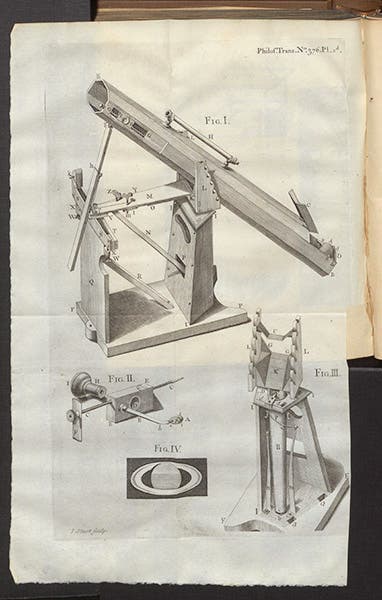
Hadley’s first reflecting telescope, presented to the Royal Socety, engraving accompanying “An account of a Catadioptrick telescope,” by John Hadley, Philosophical Transactions of the Royal Society of London, vol. 32, no. 376, 1723 (Linda Hall Library)
John Hadley, an English instrument maker, died Feb. 14, 1744, at the age of 62. Not much is known about Hadley's life except that he came from a wealthy family and had two brothers who helped him in the workshop. He first came to scientific attention in 1721, when he demonstrated a new telescope to the Royal Society of London. It was, as he called it in the title of the paper he later published, a "Catadioptrick telescope", which means it was made with mirrors.
Nearly every telescope in use in the world in 1721 was a "Dioptrick telescope," or, as we would now call it, a refractor, meaning it used lenses to gather light and magnify an image. Galileo's first telescope was a refractor, and so were the much improved telescopes of Johannes Hevelius, Giovanni Domenico Cassini, and nearly every other investigator of the heavens. There was nothing wrong with refractors – they are still in widespread use, and I own one myself – but to be effective at high magnifications, they had to be very long. The Royal Society owed an aerial refractor made by Christiaan Huygens that was 123 feet long. They could be difficult to use.
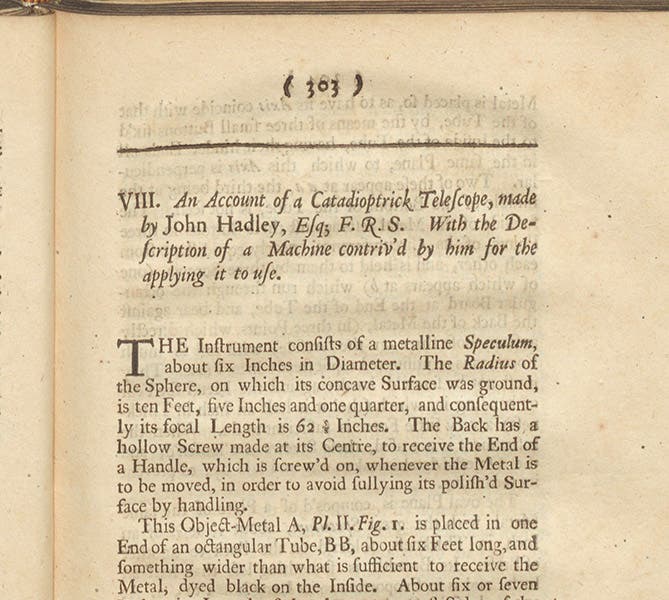
Detail of first page of article, “An account of a Catadioptrick telescope,” by John Hadley, Philosophical Transactions of the Royal Society of London, vol. 32, no. 376, 1723 (Linda Hall Library)
Isaac Newton had built a new kind of telescope in 1668, one that used a mirror to gather the light, with an eyepiece lens to magnify the image. The mirror for his reflector, which he ground himself from a metal alloy, was about 2 inches across, and it sent the reflected light back up the six-inch tube to a tiny 45-degree flat mirror, which deflected the image sideways to the eyepiece. Such a mounting system came to be called a Newtonian mount, and it is in use to this day. Newton did not invent the reflector; many other people thought of it, and devised other mounting systems as well, such as those of James Gregory and Laurent Cassegrain, where the secondary mirror was curved and focused the light back through a hole in the center of the primary mirror. But it was hard to make any of these telescopes, since first you had to come up with a recipe for a metal alloy that would take a high polish and would not corrode, and then you had to devise ways to grind the metal mirror to the precise parabolic shape needed and then correct and polish it. No one figured out how to do this in practice, until Hadley.
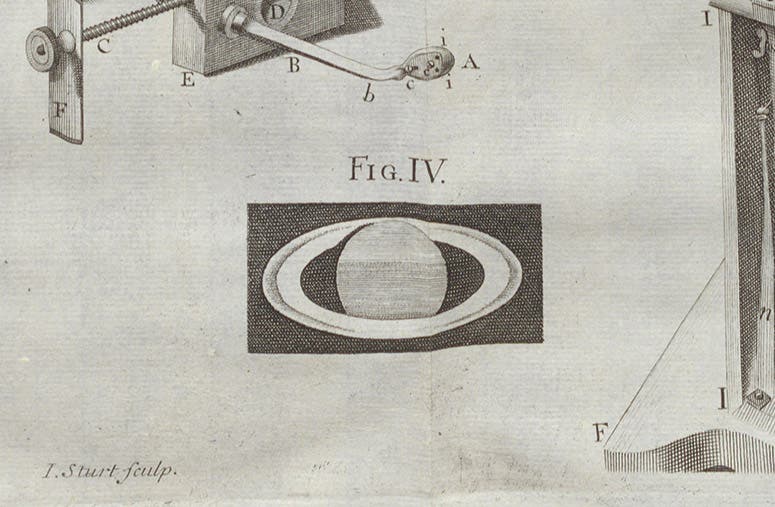
Drawing of Saturn as viewed through John Hadley’s reflector, detail of first image (Linda Hall Library)
Hadley's telescope was a Newtonian, with a tube six feet long and a mirror six inches across, which is quite respectable. He presented it to the Royal Society in 1721, along with a drawing he made of Saturn as viewed through his telescope (fourth image). A diagram of his reflector was published in the Philosophical Transactions of the Society (first image), along with a full description of its construction and use. Several members, James Bradley and Samuel Molyneux, immediately put it to the test. They found that Hadley’s reflector could achieve magnifications of about 200 power (Newton’s reflector had provided about 35 power), and they were able to see in its field of view five satellites of Saturn, as well as the division in Saturn’s ring. They compared it to the Society’s 123-foot Huygens refractor and found that the refractor was brighter, but the compact Newtonian reflector built by Hadley was better in every other way, especially in its maneuverability and its resolution. Hadley immediately began to produce reflectors for sale, and soon others did as well. When William Herschel bult his large reflectors later in the century, he was continuing in a practice that had been founded by Hadley, inspired in turn by Newton.
As important as Hadley's telescope was in establishing the reflector as the instrument of choice in the later 18th century, another instrument invented by Hadley might have been even more important. In 1731, Hadley presented a second instrument to the Royal Society, this one a reflecting octant for measuring the altitude of the Sun or a star. Measuring the altitude of heavenly bodies was an essential part of navigation at sea, since it allowed one to determine latitude directly. But this required measuring the angle between the Sun or a star and the horizon, a difficult task on land and a nearly impossible one on board a rolling ship. The Backstaff, the instrument used for this purpose since the Renaissance, involved putting the Sun behind you and lining up its shadow with the horizon, which was ingenious, but not very accurate.
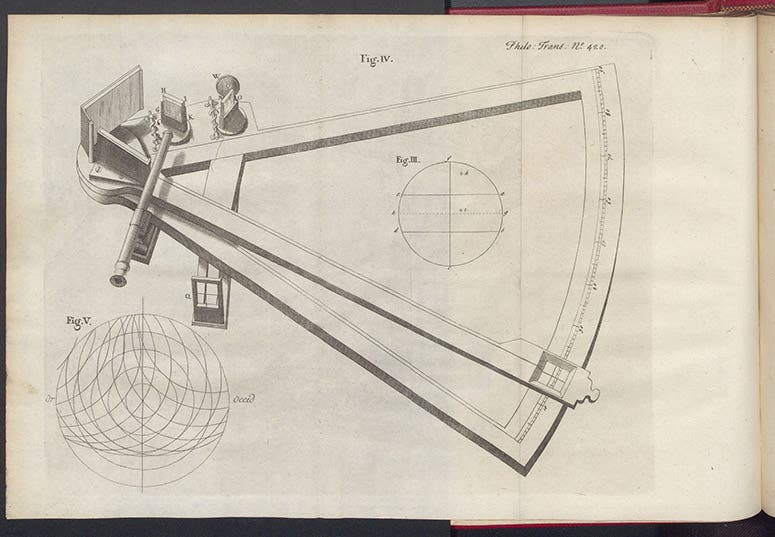
The reflecting octant devised by John Hadley, one of two engravings accompanying his article, “The description of a new instrument for taking angles,” Philosophical Transactions of the Royal Society of London, vol. 37, no. 420, 1731 (Linda Hall Library)
Hadley discovered how to do it with mirrors (as he had with his reflector). His octant had a small mirror that reflected the light of the Sun, or a star, onto another flat mirror that was half-silvered (as we would now describe it), meaning that one half was reflective, and the other transparent. If you looked through the half-silvered mirror using a sight, and aimed at the horizon, you could change the angle of the mirror reflecting the Sun until the image of the Sun coincided with the horizon. The arm controlling the solar mirror was connected to a scale, from which you could read off the angle of difference, or the altitude, to a high degree of accuracy. This then allowed you to calculate your latitude. Here is a link to a video provided by the Museum of the History of Science at Oxford University that not only shows you a Hadley-era octant, but demonstrates how to use it.
The octant (sometimes called a quadrant, because it could measure an angular difference of a quarter of a circle) was invented independently and nearly simultaneously by the Pennsylvania mathematician Thomas Godfrey, but it was Hadley’s version that was put into production, first by Hadley, and then by other London instrument makers, and it soon became a staple at sea. The reflecting octant eventually gave rise to the reflecting sextant, which was more compact and could measure a greater angular difference (120° versus Hadley’s 90°). But it utilized exactly the same optical paths that Hadley devised for his 1731 quadrant. Both instruments could also be used for determining longitude using the lunar distance method that was proposed in the 1740s. It is safe to say that without Hadley’s octant and the instruments developed from it, the Age of the Great Circumnavigations that began with Louis-Antoine Bougainville in 1766 and James Cook in 1768 might have turned out quite differently.
William B. Ashworth, Jr., Consultant for the History of Science, Linda Hall Library and Associate Professor emeritus, Department of History, University of Missouri-Kansas City. Comments or corrections are welcome; please direct to ashworthw@umkc.edu.

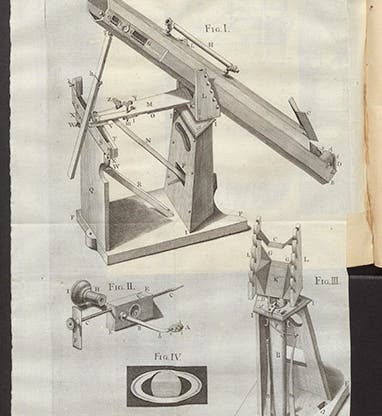
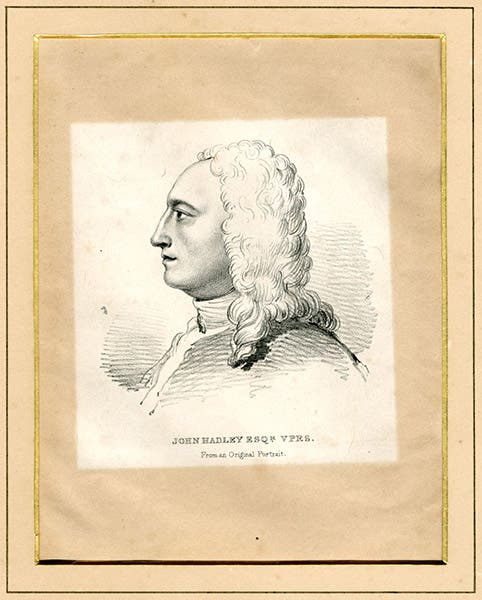
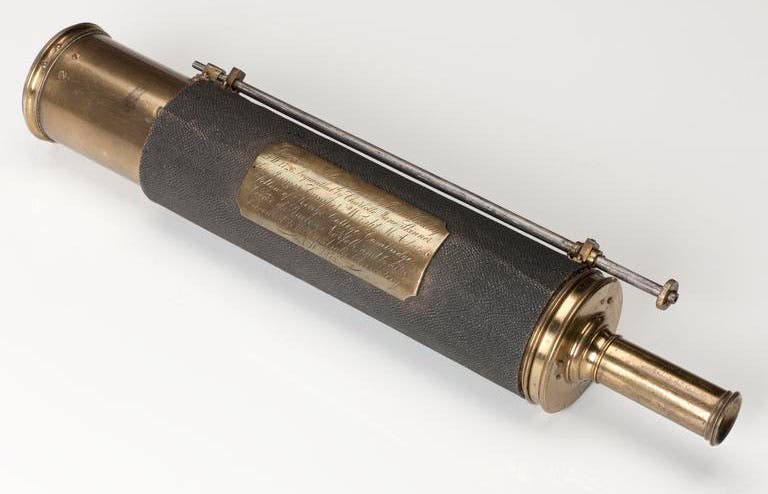




![Using an astrolabe to measure the depth of a well, woodcut in Elucidatio fabricae vsusq[ue] astrolabii, by Johannes Stöffler, 1513 (Linda Hall Library)](https://assets-us-01.kc-usercontent.com:443/9dd25524-761a-000d-d79f-86a5086d4774/a998eb50-55d2-4a88-ace2-a50aa5fa86e7/Stoffler%201.jpg?w=210&h=210&auto=format&fit=crop)